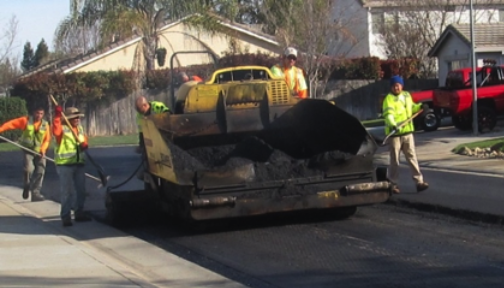Change Your Building's Landscape with Hot Mix Asphalt Paving Quality
Change Your Building's Landscape with Hot Mix Asphalt Paving Quality
Blog Article
Unlocking the Tricks of Warm Mix Asphalt Modern Technology
Exploring the depths of hot mix asphalt technology uncovers a world where precise processes and accurate formulas assemble to shape our roads and infrastructure. The fusion of fillers, binders, and accumulations isn't simply a building task but a tactical orchestration of sturdiness and efficiency. As we peer into the intricate dancing of components, a tapestry of resilience and sustainability unravels. What lies beneath this surface area of asphaltic mastery, and what secrets wait to be introduced in the realm of paving technologies?
Importance of Hot Mix Asphalt
Warm Mix Asphalt plays a crucial role in contemporary framework development due to its sturdiness and cost-effectiveness. As the most generally used paving material for roadways, freeways, and parking lots, Hot Mix Asphalt uses an array of benefits that contribute to its significance in building jobs.
The toughness of Warm Mix Asphalt originates from its make-up, that includes aggregates, binder, and filler materials that are carefully chosen and mixed to satisfy certain efficiency needs. This accurate mix causes a adaptable and solid sidewalk that can sustain regular use without considerable wear and tear. Furthermore, Hot Mix Asphalt is 100% recyclable, additional enhancing its sustainability and environmental advantages. Generally, the value of Hot Mix Asphalt in infrastructure growth can not be underrated, as it continues to be a cornerstone of modern-day building and construction practices.
Components of Asphalt Mixes
The structure of asphalt blends is composed of carefully chosen aggregates, binder, and filler products that are critical for achieving particular performance demands. Aggregates are the main part of asphalt blends, giving strength and stability. The binder, generally bitumen or asphalt cement, holds the aggregates together and supplies versatility and longevity to the mix.
The mix and percentage of these parts play a substantial role in determining the quality and performance of the asphalt mix. Designers carefully design the mix to fulfill details needs, taking into consideration variables like website traffic quantity, environment conditions, and pavement lifespan. Correct option and harmonizing of aggregates, binder, and fillers are vital for producing resilient, lasting asphalt pavements.
Combining and Manufacturing Methods

When the accumulations are chosen, the binder, commonly asphalt concrete, is included to bind the products with each other. The binder's high quality and amount dramatically influence the mix's resistance, flexibility, and strength to ecological variables. In addition, fillers like moisturized lime or Portland cement might be integrated to improve particular qualities of the asphalt mix, such as its workability or moisture resistance.
Throughout manufacturing, the aggregates and binder are heated, typically in between 250-325 ° F(121-163 ° C ), to promote blending and guarantee proper layer of the accumulations. The mixing process has to be complete to accomplish a homogeneous combination that promotes the desired efficiency qualities of the asphalt. Various strategies, such as site link batch blending or drum mixing, are employed to attain high-grade and constant asphalt mixes for building and construction jobs.
Factors Impacting Asphalt Efficiency
Variables influencing asphalt performance include an array of variables that impact the toughness, long life, and overall high quality of asphalt sidewalks. One vital element is the high quality of products made use of in the asphalt mix.

Ecological conditions likewise influence asphalt performance. Temperature level variations, dampness infiltration, and web traffic lots can all impact the architectural integrity of the sidewalk. Layout considerations, such as sidewalk density and drain, are crucial in guaranteeing the lasting performance of the asphalt pavement. By meticulously considering these contractors, elements and designers can enhance asphalt efficiency and boost the solution life of pavements.
Sustainable Practices in Asphalt Technology

WMA enables for the production and placement of asphalt blends at lower temperatures contrasted to standard hot-mix asphalt, resulting in decreased energy usage and greenhouse gas discharges. The usage of porous asphalt blends can assist mitigate stormwater drainage problems by allowing water to penetrate via the pavement and right into the ground, advertising natural water purification and reenergize procedures.
Conclusion
To conclude, hot mix asphalt modern technology plays an important duty in modern-day infrastructure advancement because of its durability and cost-effectiveness. By thoroughly balancing elements, utilizing appropriate blending strategies, and taking into consideration various elements, engineers can create top notch asphalt mixes that withstand rush hour loads and severe weather conditions. Welcoming sustainable practices, such as making use of recycled products and warm-mix technologies, even more enhances the ecological kindness of asphalt innovation.
Mixing and production strategies in warm mix asphalt innovation involve the precise mix and processing of aggregates, binder, and fillers to develop a high-performance and sturdy asphalt mix.Aspects influencing asphalt performance incorporate a variety of variables that impact the durability, long life, and general quality of asphalt sidewalks. Sustainable techniques in asphalt innovation encompass numerous efforts intended at minimizing the environmental influence of asphalt production and paving procedures. By integrating redeemed asphalt pavement (RAP) and recycled asphalt tiles (RAS) into brand-new asphalt mixes, the sector can substantially reduce the intake of raw materials and power, while also reducing landfill waste.
WMA enables for the manufacturing and placement of asphalt blends at lower temperatures contrasted to conventional hot-mix asphalt, resulting in lowered energy usage and greenhouse gas emissions.
Report this page